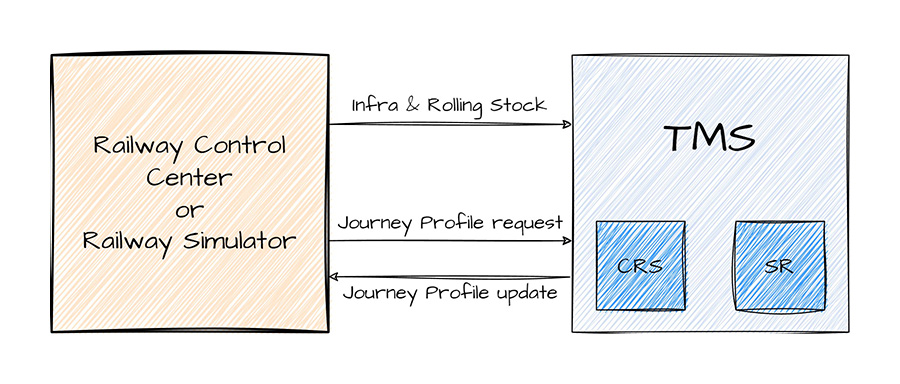How TMS works

TMS System and Communication Scheme
TMS works together with a Railway Simulator (Incontrol FRISO since 2005) or with the Railway Control Center, in case of rear-life application.
The simulator sends trains information at the beggining of a simulation such as journeys (represented by a list of timing points), routes, timetables and acceleration/decelaration models.
The optimization routine starts with the simulator sending a journey profile request, providing train positions and the reaching times of timing points as each train would run alone in the network.
TMS update its internal network model and run the Conflict Resolution System (CRS) that performs the global optimization, then TMS sends back the list of timing points along with the associated optimal times calculated by CRS, such times are calculated to minimize delays but also to grant a feasible speed profile for each train.
After the optimization the Speed Regulation module (SR) uses the optimal times to send advisory speeds to trains and manage the route setting, while monitoring if the optimal plan provided is still feasible. Whenever the plan becomes unfeasible (e.g disturbances on th network or new trains entering the area) SR requests an updated optimization to CRS.
Until 2019 TMS included both the CRS and the SR modules. Since 2019 the SR module has been implemented into FRISO in order to simulate an ATO compliant Railway System.
The Conflict Resolution System (CRS) is based on the Alternative Graph, that allows an easy modeling of complex scheduling problems, the graph contains the running train journeys and all the conflicts between journeys (shared parts of the infra between two trains). Read More about Alternative Graph
The optimization process is based on a greedy euristhic approach that selects one conflict at a time and simulates both alternatives (train A pass before train B and viceversa), each simulation grants plan feasibility, speed profile feasibility and red signal avoiding by putting some distance between the two trains.
Then the different results are compared and the best one is choosed, if the two results are too close the choice can be postponed.
After all conflicts are solved the final times are collected and sent to Simulator.

Conflict Resolution Routine
